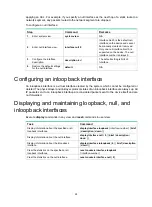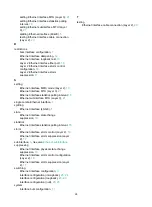
13
IMPORTANT:
This feature is used only for debugging and troubleshooting.
IMPORTANT:
This feature is used only for debugging and troubleshooting.
Perform this task to determine whether an Ethernet link works correctly.
Loopback testing includes the following types:
•
Internal loopback testing
—Tests the device where the Ethernet interface resides. The
Ethernet interface sends outgoing packets back to the local device. If the device fails to receive
the packets, the device fails.
•
External loopback testing
—Tests the inter-device link. The Ethernet interface sends incoming
packets back to the remote device. If the remote device fails to receive the packets, the
inter-device link fails.
Configuration restrictions and guidelines
•
After you enable this feature on an Ethernet interface, the interface does not forward data
traffic.
•
The
shutdown
,
port up-mode
, and
loopback
commands are mutually exclusive.
•
Enabling loopback testing on an interface will invalidate the voice VLAN, MAC learning limit,
MAC address learning, 802.1X, and MAC authentication configurations on the interface. To
make these features take effect on the interface, disable loopback testing and configure the
features again.
Configuration procedure
To enable loopback testing on an Ethernet interface:
Step Command
Remarks
1.
Enter system view.
system-view
N/A
2.
Enter Ethernet interface
view.
interface interface-type
interface-number
N/A
3.
Enable loopback testing.
loopback
{
external
|
internal
}
By default, loopback testing is
disabled on an Ethernet interface.
The
external
keyword is not
supported in the current software
version.
Configuring generic flow control on an Ethernet interface
IMPORTANT:
•
This feature is not supported on interfaces that operate in half duplex mode.
•
Enabling or disabling this feature on an interface will cause the interface to go down and then
come up.
To avoid dropping packets on a link, you can enable generic flow control at both ends of the link.
When traffic congestion occurs at the receiving end, the receiving end sends a flow control (Pause)
frame to ask the sending end to suspend sending packets. Generic flow control includes the
following types:






























